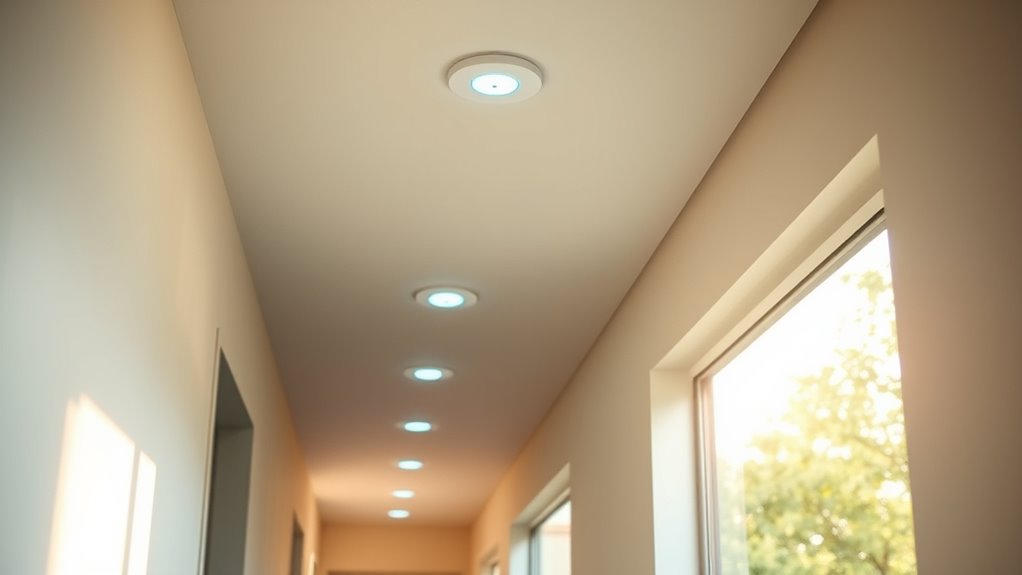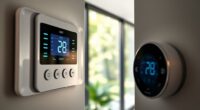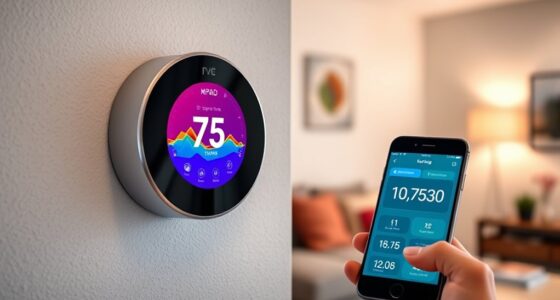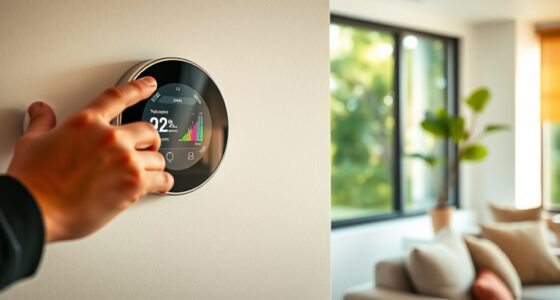Occupancy sensors help you reduce energy waste by automatically turning off lights and appliances when a room is unoccupied. They detect movement or presence to make certain lights are only on when needed, preventing unnecessary energy use. Proper installation and maintenance are key to maximizing their benefits. When you use these sensors, you create a more efficient environment, saving money and reducing your carbon footprint. Keep exploring to find out how these systems can improve your energy management even further.
Key Takeaways
- Automatically turn off lights when a room is unoccupied, preventing unnecessary energy use.
- Detect presence or movement to ensure lights operate only when needed, reducing waste.
- Enable real-time lighting adjustments based on occupancy, optimizing energy consumption.
- Integrate with building systems for coordinated control, enhancing overall energy efficiency.
- Proper installation and maintenance ensure sensors function correctly, maximizing energy-saving benefits.
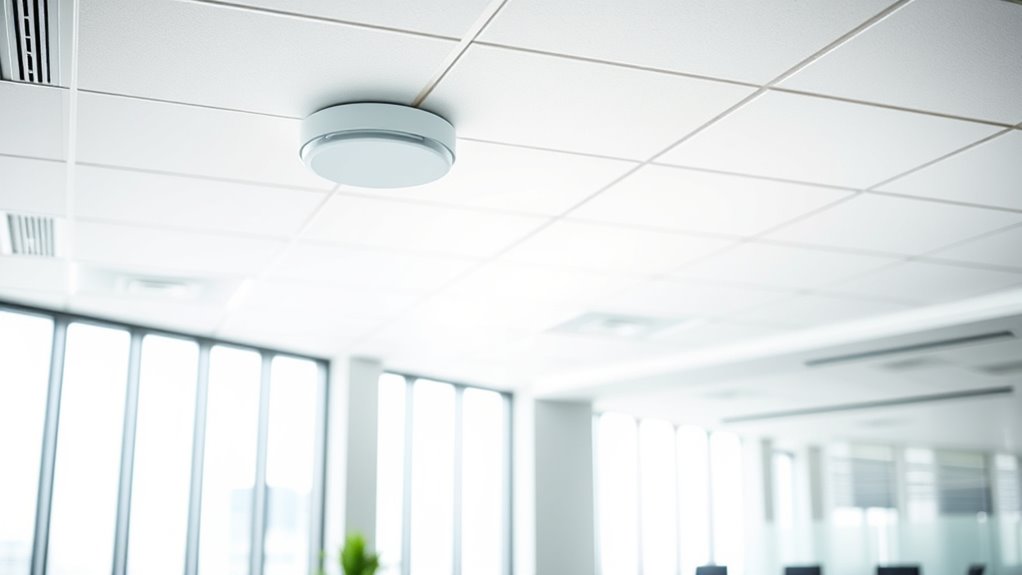
Occupancy sensors are designed to automatically turn off lights and appliances when a room is unoccupied, but when they malfunction or are improperly installed, they can actually contribute to energy waste. Properly functioning sensors, however, are a key part of smart lighting systems that considerably boost energy efficiency. By detecting movement or the presence of people, these sensors ensure lights are only on when needed, preventing unnecessary energy consumption. This automation means you don’t have to remember to turn off switches, reducing the chances of leaving lights on in empty rooms. As a result, you save electricity and lower your utility bills, making occupancy sensors a practical investment in sustainable living.
Occupancy sensors save energy by turning lights off when rooms are unoccupied, preventing waste and reducing utility bills.
Smart lighting, integrated with occupancy sensors, optimizes energy use across your home or workspace. Instead of traditional lighting that stays on regardless of occupancy, smart lighting systems adjust based on real-time activity. When you enter a room, the sensors turn on the lights instantly, and when you leave, the lights turn off automatically after a preset period. This seamless operation minimizes wasted energy and ensures your lighting is only active when necessary. Because these sensors can be calibrated to specific preferences, you gain precise control over lighting behavior, further enhancing energy savings. Plus, with smart lighting, you can often customize settings remotely through apps, giving you even more flexibility and oversight.
In addition to reducing unnecessary electricity use, occupancy sensors contribute to a more sustainable environment. Less energy consumption means fewer fossil fuels are burned to generate power, which diminishes your carbon footprint. Many modern sensors are energy-efficient themselves, consuming minimal power to operate. This means they help you conserve energy without adding to your electricity bill, making them a smart choice for eco-conscious households and businesses. Moreover, some sensors can be integrated with building automation systems, allowing for complete energy management. This integration ensures lighting, heating, and cooling systems work together efficiently, further reducing overall energy waste.
However, to maximize their benefits, you need to verify proper placement and calibration of occupancy sensors. Incorrect installation can lead to lights turning off prematurely or not turning on when needed, negating their energy-saving purpose. Regular maintenance and adjustments ensure these devices operate smoothly, providing consistent energy efficiency. When set up correctly, occupancy sensors become silent partners in your effort to reduce waste, creating smarter, more sustainable environments. They turn ordinary lighting into a dynamic, responsive system that aligns with your actual needs, saving energy and supporting your sustainability goals without sacrificing comfort or convenience.
Frequently Asked Questions
Can Occupancy Sensors Be Integrated With Existing Building Management Systems?
Yes, you can integrate occupancy sensors with your existing building management systems through smart integration. Ensuring system compatibility is key; most modern sensors are designed to work seamlessly with popular BMS platforms. You might need an interface or controller, but many manufacturers offer compatible solutions. This integration allows you to optimize energy use further, automate lighting and HVAC controls, and improve overall building efficiency with minimal disruption.
What Is the Typical Lifespan of an Occupancy Sensor?
You can expect an occupancy sensor to last around 8 to 10 years, depending on its sensor durability and usage. Regular maintenance and proper installation help extend its lifespan, reducing the need for frequent replacement. Keep an eye on performance, and if you notice it’s not responding as well, it might be time for a replacement. Overall, choosing quality sensors guarantees longer-lasting performance with fewer replacement needs.
Are There Any Privacy Concerns With Occupancy Sensors?
Yes, privacy concerns can arise with occupancy sensors, especially regarding data security. You might worry about how your movement data is stored or shared. To address this, verify the sensors you choose have strong data security measures and clear privacy policies. It’s important to understand how your information is used and to select devices that prioritize user privacy, giving you peace of mind while benefiting from energy savings.
How Do Occupancy Sensors Perform in Outdoor Environments?
Imagine a sensor standing firm under rain, snow, or blazing sun—outdoor durability and weather resistance maintain it working flawlessly. You’ll find occupancy sensors outdoors perform reliably, detecting movement despite harsh conditions. Their rugged design ensures they resist water, dust, and temperature extremes, so your energy-saving system stays active year-round. With these sensors, you confidently automate outdoor lighting and security, knowing they’re built to withstand nature’s toughest challenges.
What Maintenance Is Required for Optimal Sensor Performance?
You should regularly check your occupancy sensors for proper operation. Calibrate the sensors periodically to guarantee accurate detection, especially if you notice lights turning off or on unexpectedly. Replace batteries as needed to maintain reliable performance, typically every 1-2 years depending on usage. Keep the sensor lenses clean and free from dust or debris. Proper maintenance guarantees peak sensor calibration and prevents false readings, maximizing energy savings and ensuring consistent lighting control.
Conclusion
By installing occupancy sensors, you can cut down on energy waste effortlessly. They turn off lights when no one’s around, saving you money and reducing your carbon footprint. Think of it like a wise old saying: “A stitch in time saves nine.” When you act now to automate lighting, you prevent waste before it happens. Embrace occupancy sensors today—small change, big impact, and a brighter, greener future for all.
